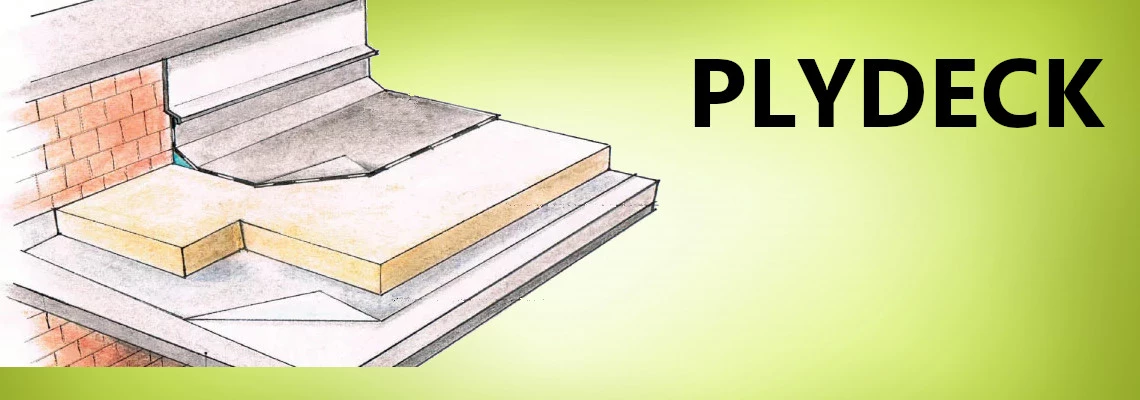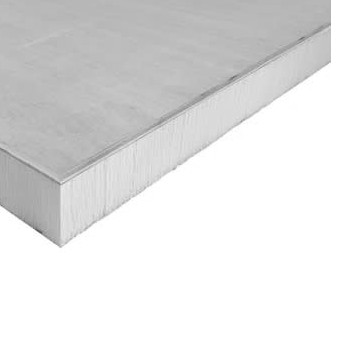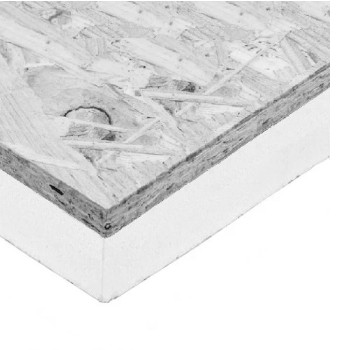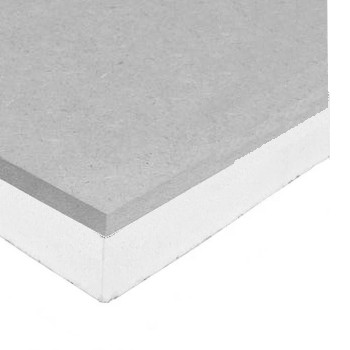
PLYWOOD WITH INSULATION ATTACHED*
Insulation was invented first, then plywood. Later, the wise man decided to combine those two products. That's simply how pre insulated plywood called plydeck was born.
Today insulation backed plywood is known as an extremely easy building material to work with as part of your build, meaning that the average project is completed in a shorter space of time. To put it into perspective, a flat roof project which would usually take a couple of days can be completed in hours with insulated plywood.
It is vital to understand all the advantages and disadvantages of pre insulated plywood before buying the product, as that would help you decide whether to opt for OSB, or, alternatively, MDF instead. By reading this article, you will find out what kind of insulated panels are available on the UK market and where you can use them. The insulated ply costs given here are given in good faith as an indicative guide only and should be used with understanding. Insulationgo Limited cannot accept any liability for any budget produced using these figures.
INSULATED PLYWOOD ROOF PANELS / FLAT ROOF INSULATION WITH PLYWOOD
 Plywood is relatively strong itself as it is numerous layers of wood pressed together. When insulation such as PIR is added to plywood it is even stronger. In fact, insulated plywood delivers excellent levels of strength being made up of 2 layers. Therefore it is ideal for roofing jobs. Plywood skin is easy and simple to apply to any roof. Used primarily for their strength, they are rated by their exposure capability and the grade of veneer used on the face and back. While both insulated OSB and Plywood offer similar performance in terms of strength and functionality, the Plywood panel is about 7% stronger.
Plywood is relatively strong itself as it is numerous layers of wood pressed together. When insulation such as PIR is added to plywood it is even stronger. In fact, insulated plywood delivers excellent levels of strength being made up of 2 layers. Therefore it is ideal for roofing jobs. Plywood skin is easy and simple to apply to any roof. Used primarily for their strength, they are rated by their exposure capability and the grade of veneer used on the face and back. While both insulated OSB and Plywood offer similar performance in terms of strength and functionality, the Plywood panel is about 7% stronger.
As one of the few materials available on the market, insulated plywood is especially suitable for insulating warm roofs. Why? Warm roof insulation works by putting the insulation material on top of the roof. Only then, the insulation stops the development of damp and decay by allowing moisture to escape, and as a result, it is thought to be the best option for the UK climate.
Using insulated plywood panels on a flat roof allows you to insulate the roof and provide a perfect base for the roofing felt in one go. Moreover, insulated plywood sheets are highly durable and can handle being walked on. It is even more important if you consider the fact that roofs need to be able to withstand human weight. You should expect to pay anything between £64- £75 for a 25mm panel.
The insulation for a warm roof will usually be plywood boards bonded to rigid compressed boards. That includes:
- 25mm Kingspan Thermaroof TR26
- 26mm PLY FR/TP Xtratherm Thin-R
- 96mm Celotex TD4000 PIR Plywood
- 96mm Recticel Plylok PIR
ADVANTAGES: speed of installation, 2 in 1 product, compact, strength & density.
DISADVANTAGES: expensive, extended lead time-custom product, low fire ratings.
PRICE/M2: £12/m2
OSB WITH INSULATION ATTACHED / INSULATION BACKED OSB
 Depending on the design, you can choose from various types of backed boards layer setups. OSB with insulation attached is one of the options available.
Depending on the design, you can choose from various types of backed boards layer setups. OSB with insulation attached is one of the options available.
Panel is basically made up of two sheets: Oriented Strand Board (OSB3) and a sheet of PIR rigid insulation (PolyIsocyanuRate). They are glued together forming one large, very rigid and well insulated panel.
In fact, PIR core offers the highest R-value of any material per thickness and is one of the most capable and valuable heat resistant materials in UK constructions that can be used to build energy saving panels.
OSB absorbs water more slowly than plywood, which can be beneficial in areas of low dampness.
Insulated OSB boards can be finished with traditional materials such as brick slip, weatherboards, slates, tiles or metal sheets. OSB with insulated panels reduce jobsite labour needs by 45%.
Good mechanical properties and excellent adhesion of the wood and PU composite mean the material has a wide range of applications such as flooring, roofing, garden room, house extension, shed, gym or chill-out room. As the panels provide the insulation and structure, there is no need for the external finish to provide any structural support, other than to support itself. The OSB insulated panel is slightly cheaper than its opponent PLY. You should expect to pay around £ 45 per board.
The insulation attached to OSB include:
24mm Xtratherm Plydeck PIR OSB Flat Roof Insulation
ADVANTAGES: more affordable than the PLY version, more dense than plywood, uses tree farms instead of forest growth.
DISADVANTAGES: swelling when wet, dries a lot slower than plywood, difficult to paint, surface with knots.
PRICE/M2: £10/m2(25mm)
INSULATED PLYWOOD WALL PANELS
Insulated plywood wall panels are often associated with single sided Structural Insulated Panels called SIP. Board insulates and builds the walls in one simple application. This form of board creates a tremendously strong wall section, which requires little, if any, further support. Internally, insulated plywood boards can be finished with materials such as weatherboards, brick slips or decorative tiles.
Insulated plywood wall panels have a higher R-value than conventionally built walls, especially if PLYWOOD is used. However being partially made of wood they do not have adequate fire performance ratings. When exposed to moisture, panels with plywood facings may form unhealthy mould that can diminish the air quality of a home or building.
Insulated plywood walls resist up to 10417.15kg per m which results in structures that are stronger and straighter. Panels deliver unrivalled insulation, which reduces energy costs over the building’s lifetime. Boards are all-in-one – they act as the structural framing, insulation and air barrier. Building walls with insulated plywood can save you 28% of time on the construction plan if not more and up to 3% of construction costs.
The insulated panels for the walls will usually be :
ADVANTAGES: lightweight, easy to install, ready for decorative finish.
DISADVANTAGES: some people find it hard to cut, price.
PRICE/M2: £12/m2(25mm)
MARINE PLY WITH INSULATION
Marine ply with insulation is a high-quality face plywood bonded to PIR core insulation designed for places where high humidity or damp may be a concern, such as kitchens, bathrooms, external walls, garages or sheds. Its exterior phenolic resin glue gives long life in high humidity and wet conditions. It has a superior surface finish which is very smooth and soft to touch.
Marine plywood with insulation is also an excellent option for making saunas. Therefore, this kind of product is mainly used in boats to insulate cabins.You can also use it as waterproof wall panels. Moreover, it is a great alternative to other commonly used insulation solutions, such as rock wool. Marine ply doesn’t crack or warp either.
No matter what the size of your boat, you can rest assured that marine insulated ply solution will help you to protect the interior from some of the most commonly experienced problems on the open water.
Regardless of the size of the board, you only have the standard standard size option 2.4m x 1.2m. Marine plywood price is usually 20% higher than that of regular plywood. Insulated marine plywood ranges in price from £68 per board to £198 depending on thickness.
ADVANTAGES: excellent pliability compared to other structural plywood, water-resistant.
DISADVANTAGES:expensive, contain chemicals, low fire ratings, bends easily when it is overloaded.
PRICE/M2: £19/m2
INSULATED MDF BOARD
 Medium Density Fibreboard such as MDF sheet being smooth sanded can be used to make furniture, panelling, cabinets or internal joinery. It consists of refined wood grits that are mixed with wax and resin and pressed under immense pressure and temperature to form flat panels. Because it comes with a smooth surface it is suitable for applying surface paint and finishes. When an insulation core such as PIR is added it creates a construction product, ideal to make insulated custom doors. Insulated MDF board is also good to be used as a food storage container. Boards come in 8’ x 4’ size (2400mmx1200mm) and are always square edged. The price you should be prepared to pay is £86 per 38mm (20mm PIR+18 MDF) thick board which is equal to £29/m2.
Medium Density Fibreboard such as MDF sheet being smooth sanded can be used to make furniture, panelling, cabinets or internal joinery. It consists of refined wood grits that are mixed with wax and resin and pressed under immense pressure and temperature to form flat panels. Because it comes with a smooth surface it is suitable for applying surface paint and finishes. When an insulation core such as PIR is added it creates a construction product, ideal to make insulated custom doors. Insulated MDF board is also good to be used as a food storage container. Boards come in 8’ x 4’ size (2400mmx1200mm) and are always square edged. The price you should be prepared to pay is £86 per 38mm (20mm PIR+18 MDF) thick board which is equal to £29/m2.
ADVANTAGES: easy to drill, smooth surface without kinks and knots, doesn’t expand due to temperature fluctuations, treated with special chemicals that make it resistant to termites.
DISADVANTAGES: more difficult to work with, price, cannot withstand extreme stress, need a lot of labour when cutting, sanding or installing.
PRICE/M2: £29/m2
25mm INSULATED PLYWOOD
When living in London, where square footage comes at a premium, every inch counts. This is where a two-component product comes in handy. The 25mm insulated plywood is the most favoured option chosen by investors when insulating a floor. It consists of a 20mm insulation core laminated to 6mm plywood. The 20mm PIR insulation achieves a lambda value (thermal conductivity) of just 0.022W/mK across all thicknesses. Panels have a good compressive strength. 1m2 of the insulated plywood is capable of supporting the weights: 120 kg/m3 which is equal to 112 tonnes.
PRODUCTS:
*All the information provided in the content published on Insulationgo blog is for informational and educational purposes only. Insulationgo LTD makes every effort to ensure the accuracy and timeliness of the content, but we do not assume any responsibility for any errors or omissions.
The information presented on this blog should not be considered as professional advice or a substitute for consulting relevant experts. Before making any purchase decisions or taking action based on the information presented here, it is strongly recommended to contact the product manufacturer directly to verify the details and ensure its suitability for your specific needs.
By using this blog, you acknowledge and agree that Insulationgo LTD shall not be held liable for any damages, losses, or inconveniences arising from the use or reliance on the information provided herein. This limitation of liability applies to all users of the blog, including but not limited to visitors, readers, and subscribers.










































































































